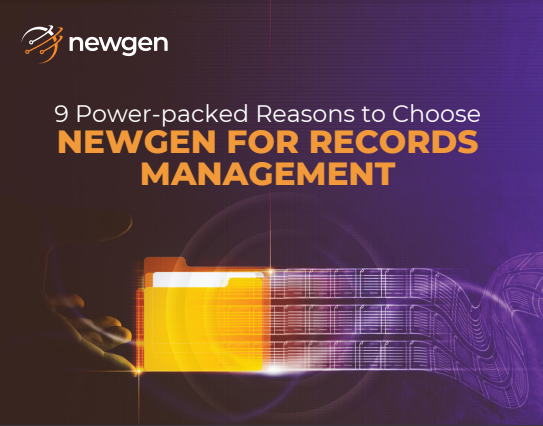Why Records Management Can Make or Break Your Organization?
Every business runs on records like contracts, emails, tax filings, reports, product designs, and even social media interactions. But when those records are scattered, unmanaged, and hard to find, it can cause chaos: compliance violations, legal risks, operational delays, and poor customer experience.
Manual processes and disconnected storage systems often lead to:
- Wasted time searching for critical files
- High compliance risk and potential penalties
- Inefficient audits and legal challenges
- Rising storage costs with no clear structure
The answer? A modern, AI-powered Records Management System (RMS) that organizes, secures, and automates the entire lifecycle of your records — from creation to secure disposal.
Why Choose Newgen’s RMS?
Newgen’s RMS helps you take control of enterprise-wide records with an AI-first, low-code platform designed for security, compliance, and agility. Here’s how it transforms records management into a growth enabler:
1. Automate the Mundane and Boost Efficiency
Let AI and robotic process automation handle repetitive tasks:
- Automatic Classification: AI scans and tags records by type, keywords, and metadata.
- Metadata Extraction: Capture important details like contract dates or invoice numbers instantly.
- Workflow Automation: Route approvals, send reminders, and trigger retention schedules automatically.
Result: An invoice arriving via email can be classified and sent to finance without any manual work.
2. Simplify the Entire Records Lifecycle
From creation to archival and secure disposal, Newgen’s RMS makes the journey seamless:
- Omnichannel Capture: Pull in records from emails, scanned documents, social media, and third-party apps.
- Intelligent Processing: Keep records proactively maintained and easily retrievable.
- Archival & Disposition: Securely store inactive records long term and automatically delete them after retention periods.
For example, a financial institution can capture customer agreements from email, auto-classify them, archive post-closure, and securely delete when policies require.
3. Build Policy-Driven Governance With Ease
Stay compliant with global and local regulations:
- Retention Rules: Set how long different record types should be stored (e.g., seven years for US tax filings).
- Disposition Schedules: Automate archival or secure deletion without manual tracking.
- Cutoff and Rollover Rules: Manage periodic closures, such as ending fiscal-year records.
No more compliance guesswork — your retention and deletion policies run automatically.
4. Stay Organized at Scale
A structured, metadata-driven hierarchy makes retrieval easy even in massive repositories:
- File Plan Numbering: Assign clear identifiers to each record (e.g., LEGAL-2024-001).
- Metadata-Driven Structure: Organize logically across departments and record types.
This helps fast-growing enterprises avoid chaos and maintain control as data volumes soar.
5. Safeguard Sensitive and Critical Information
Protect high-value records during investigations or audits:
- Legal Holds: Lock files to prevent deletion or alteration.
- Audit Trails: Track every user action — creation, access, edits, deletion — for full accountability.
Example: A healthcare provider can freeze patient communication records during a regulatory inquiry while preserving integrity.
6. Find and Share Information Instantly
End the search frustration with:
- Advanced Search: Search across file plans, metadata, and content in seconds.
- Omnichannel Distribution: Share securely via portals, mobile apps, or email with access controls.
Teams save hours and improve collaboration without compromising security.
7. Scale Securely and Remotely
Designed for cloud-native growth:
- Role-Based Access Control: Give the right people the right level of access.
- Data Encryption: Protect data in storage and transit.
- Cloud Scalability: Expand easily as data grows and enable remote access without losing control.
Example: A healthcare provider manages increasing patient records while meeting HIPAA requirements.
8. Optimize Storage Costs
Use your storage efficiently:
- Active vs. Inactive Storage: Keep high-use records handy, move older data to secondary storage.
- External Archival: Shift rarely used records to long-term storage or trusted providers.
This helps reduce primary storage expenses and maintain lean, fast-access systems.
9. Streamline Transfers and Requests
Moving and accessing records becomes simple and transparent:
- Incoming/Outgoing Requests: Track approvals and movement of files easily.
- Automated Transfers: Shift records between departments, locations, or storage types with predefined rules.
- Secure Disposal: Safely destroy data flagged for deletion, ensuring compliance and security.
Compliant and Trusted Globally
Newgen’s RMS is recognized and built to meet stringent global standards:
- DoD 5015.02 Certified for records management
- ISO 15489 & ISO 16175 compliance for best practices
- VERS Certified for long-term digital preservation
- Recognized as a Leader in the 2025 Forrester Wave™ Content Platforms
Real-World Impact
Organizations across industries such as banking, healthcare, manufacturing, and retail have seen:
- Faster audits and inspections with easy retrieval and automated compliance
- Improved operational efficiency with reduced manual effort
- Future-ready scalability to handle growing records without added complexity
Why Act Now?
Poor records management costs more than time as it risks compliance fines, lost opportunities, and damaged reputation. As regulations tighten and data volumes grow, manual and fragmented systems can’t keep up.
By adopting Newgen’s AI-powered RMS, you create a secure, intelligent, and future-ready records strategy that scales with your business.
Start Your Records Transformation
If your organization struggles with record sprawl, compliance complexity, or audit inefficiencies, now is the time to act.

